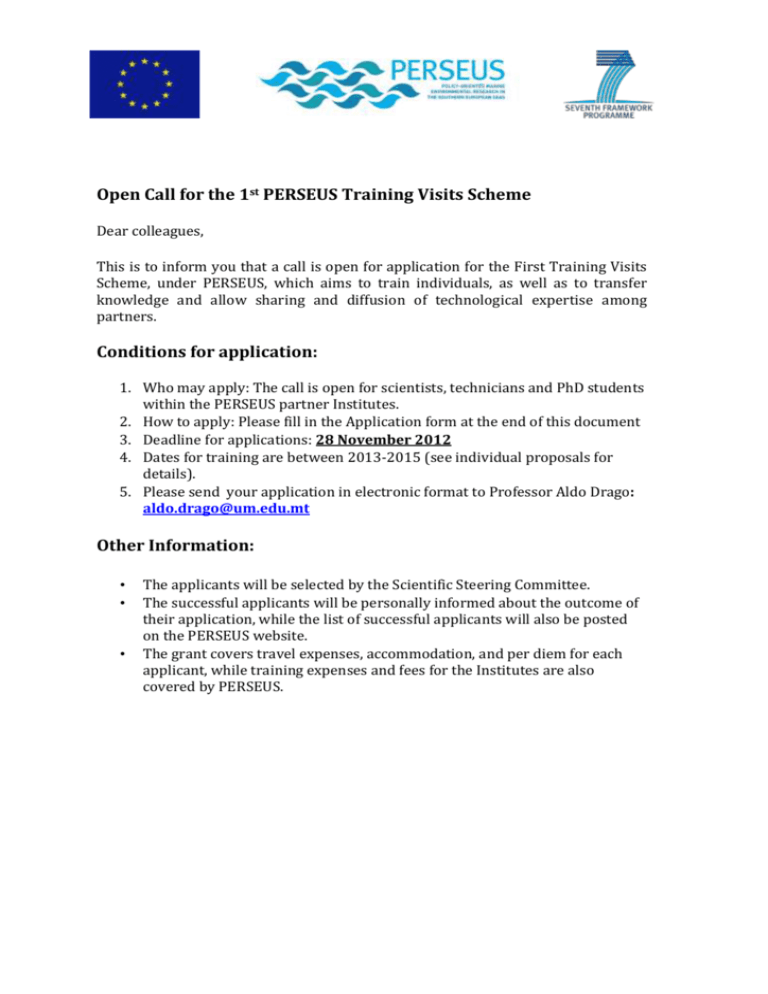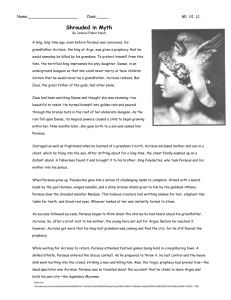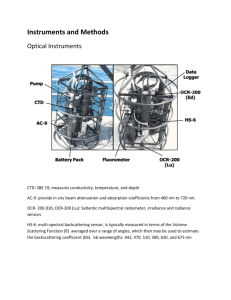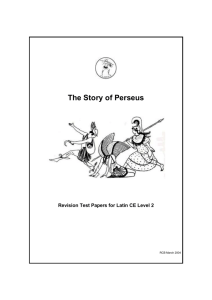Training Visits Scheme Call - November 2012
advertisement

Open Call for the 1st PERSEUS Training Visits Scheme Dear colleagues, This is to inform you that a call is open for application for the First Training Visits Scheme, under PERSEUS, which aims to train individuals, as well as to transfer knowledge and allow sharing and diffusion of technological expertise among partners. Conditions for application: 1. Who may apply: The call is open for scientists, technicians and PhD students within the PERSEUS partner Institutes. 2. How to apply: Please fill in the Application form at the end of this document 3. Deadline for applications: 28 November 2012 4. Dates for training are between 2013-2015 (see individual proposals for details). 5. Please send your application in electronic format to Professor Aldo Drago: aldo.drago@um.edu.mt Other Information: • • • The applicants will be selected by the Scientific Steering Committee. The successful applicants will be personally informed about the outcome of their application, while the list of successful applicants will also be posted on the PERSEUS website. The grant covers travel expenses, accommodation, and per diem for each applicant, while training expenses and fees for the Institutes are also covered by PERSEUS. 1. TECHNICAL DETAILS OF THE TRAINING Institute Country Chief scientist Relevance to WPs Laboratoire France Prof. Louis WP1 d'Oceanographie de Legendre Villefranche (LOV) Automated counting, sizing and recognition of zooplankton Topic Short description of Topic Training duration Micro- and macrozooplankton are key components of pelagic marine ecosystems, but sample analysis is time consuming. The training proposed here is aimed at providing methods of obtaining data on plankton > 10 µm (mostly zooplankton) in a rapid way compatible with PERSEUS goals. Imaging systems together with computerassisted recognition can be used to accelerate the analysis. The counterpart is a lower taxonomic resolution than traditional microscopic analysis, so the system is a complementary method to the traditional one and can help to focus on a specific subset of samples. Using the Flowcam and Zooscan we can, on a routine basis, analyse up to 100 groups of organisms and detect significant ecological dynamics. The Flowcam and ZooScan hardware together with the ZooProcess and Plankton Identifier (PkID) software make up an integrated analysis system for the acquisition and classification of digital zooplankton images from preserved zooplankton samples. Zooplankton samples are digitized and processed by the ZooProcess and PkID to detect, enumerate, measure and classify the digitized objects. A semi-automatic approach that entails automated classification of images and the following manual validation provide a rapid and accurate classification of zooplankton and abiotic objects. The trainees will get hands-on experience in using the two imaging systems described above (Flowcam, ZooScan) and the associated software (ZooProcess, Plankton Identifier-PkID). They will learn how to interpret the data, including the derivation of ecological indicators. The trainees would be welcome to bring their own samples, acquired for example during PERSEUS cruises. The trainees will learn how (1) to use laboratory-imaging systems for plankton analysis, (2) to derive ecological indicators from the data produced by these systems, and (3) to understand the advantages and limits of such systems. Back at their home institutions, the trainees could independently use these commercially available instruments for their own research. 30 days (up to 45) Number of trainees 2 (per period) Training period All year round, but not July and August Equipment to be deployed/used during training Brief description of methodologies/ protocols to be deployed/used during such training Expected outcomes/ deliverables of the training to be conducted1 1 AUTOMATED COUNTING, SIZING AND RECOGNITION OF ZOOPLANKTON May include sampling survey, analysis of existing samples, technical report, scientific publication, etc 2. TECHNICAL DETAILS OF THE TRAINING Institute Country Chief scientist Biophysics Institute, CNR Italy Topic Marine Carbon Cycle Dissolved organic matter dynamics and marine ecosystem health Short description of Topic Marine dissolved organic matter (DOM) represents the largest, most complex and least understood reservoir of organic carbon on the Earth. The importance of DOM is connected to its ecological significance and its central role in the global carbon cycle. It is produced at each level of the marine food web and it represents the source of energy for heterotrophic bacteria. Its colored fraction (CDOM) adsorbs light at UV and visible spectral regions, influencing the underwater light availability in open and coastal regions with important implication on primary production and biological activity. DOC and CDOM can give indirect information about the status of health of the marine ecosystem. In fact abnormal DOC concentrations (both too high and too low) or particular features of optical properties of CDOM are an alarm bell on the health of the ecosystem. DOM can be considered as the summary of all the biological processes occurring in the sea, so not only does it give integrated information about how the food web and the microbial loop functions, but it also influences and is influenced by all the physical, chemical and biological processes occurring in the oceans. Equipment to be deployed/used during training Chiara Santinelli Relevance to WPs WP1, WP2, WP4 Total organic carbon analyser, Shimadzu (TOC-5000A; TOCV CSN) FLUOROMAX4 fluorometer with a Photon Counting detector for ultimate sensitivity Jasco V550 UV/VIS spectrophotometer Brief description of methodologies/ protocols to be deployed/used During the training the applicants will receive basic training in the instruments’ use and lectures about the importance of DOM as an indicator of the ecosystem health. They will participate in (1) a oneday survey to collect samples (2) the filtration and treatments of samples (3) the analysis of the samples in order to gain information on DOC concentration and CDOM optical properties (absorption and fluorescence) (4) the elaboration and interpretation of the data collected during the training and the historical data collected by IBFCNR. The DOC concentration will be determined by the high temperature catalytic oxidation. In order to get information on CDOM the absorption spectra will be measured in the range 220-800 nm and the spectral slope will be calculated by non-linear interpolation. Fluorescence emission spectra (ex =280 nm and 355 nm) as well as excitation emission matrix will be registered (ex = 220-450 nm; ex = 300-600 nm) and they will be analysed by using the parallel factorial analysis (PARAFAC), in order to obtain information on the different kinds of fluorophores occurring in CDOM pool. The following programs will be used for data elaboration: Matlab, Origin, Sigmaplot and Ocean Data View. Expected outcomes/ deliverables of the training to be conducted At the end of the training the applicants will be requested to produce a technical report and a presentation of the results obtained during the training. Training duration Number of trainees Training period 3 weeks 3 May - June 2013 & March - June 2014 3. TECHNICAL DETAILS OF THE TRAINING Institute Country Chief scientist HCMR Topic Short description of Topic Equipment to be deployed/used during training Relevance to WPs Greece Catherine WP2 Tsangaris Biochemical biomarker techniques for the assessment of pollution effects in marine organisms Biomarkers are among the emerging tools for the assessment of pollution effects in marine ecosystems. Biomarkers are biochemical, physiological and behavioral responses that signal exposure to and/or adverse effects of anthropogenic contaminants. Training will be provided on biochemical biomarker techniques i.e. metallothionein content, acetylcholinesterase, catalase and glutathione-S-transferase activities. Participants will be trained on the above techniques using samples provided by HCMR and subsequently will analyze their regional samples. Prior to the training visits, participants will collect indicator organisms from their regional sampling sites at reference and pollution hot spot areas (2-4 sites per participant) and transfer them to HCMR for the biomarker analyses. The mussel Mytilus galloprovincialis is the proposed indicator organism, but if this species is not available at the participant’s working areas alternative indicator organisms will be considered. Training will include lectures, and laboratory analyses. An intercalibration exercise will be subsequently carried out among laboratories that will apply the biomarker techniques. The target is to exchange and apply common analytical protocols in order to assess biomarker levels in different sub regions and produce data of biological effect measurements from areas where relative information is poor. Balance, Homogeniser, Microcentrifuge, Absorbance microplate reader, Spectrophotometer, Deep freezer. Sample preparation: Brief description of methodologies/protocols Just after the collection of mussels, the gills and digestive glands are dissected, frozen in liquid nitrogen and stored at to be deployed/used 80º C until analysis. Tissues are homogenized in a buffer and centrifuged following the appropriate procedure for the analysis to be performed. Expected outcomes/deliverables of the training to be conducted Training duration Number of trainees Training period Analytical methods: Metallothioneins content is measured spectrophotometrically according to Viarengo et al. (1997). The method is based on the estimation of the sulphydryl content of MTs proteins by spectrophotometric determination of the -SH groups using Ellman’s reagent. AchE activity is assayed by the method of Ellman (Ellman et al., 1961) adapted to microplate reading by Bocquené et al. (1993). CAT activity is measured by the method of Cohen et al. (1996) by the loss of H2O2 that is measured colorimetrically with ferrous ions and thiocyanate on a microplate reader. GST is measured by the method of Habig and Jacoby (1981) with 1-chloro-2,4-dinitrobenzene (CDNB) as a conjugation substrate adapted to microplate reading. Establishment of a network of scientists working on biomarkers of pollution A common publication on the comparative study of biomarkers of pollution in different SES regions 3 weeks per training period (2 subsequent training periods of 6 weeks total duration) 5 (10 in total) May-June 2013 APPLICATION FORM 1st PERSEUS Training Visits Scheme Grant Agreement No. 287600 Please fill in all sections clearly in English. Complete and detailed answers are required in order to ensure the most appropriate selection of candidates. Name of Applicant E-mail Contact Address Phone Fax Nationality Current Institute Affiliation Position Gender Age Group Training course (Please mark one choice) Short CV (not more than 1 page; please continue on a separate page if necessary) Male 20-30 1 Female 30-40 40-50 2 50 + 3 Please indicate why you have chosen this specific course and describe what you hope to achieve, professionally and personally, by completing the training. Late or incomplete applications will not be considered Kindly also note that successful applicants will be required to obtain adequate medical and other insurance cover for their entire stay in the country hosting the training course. This expense is not covered by the scholarship package and participants are to make the necessary arrangements and cover these costs personally. I certify that my statements in answer to the previous questions are true, complete and correct to the best of my knowledge __ Candidate’s signature ____________________ Date








